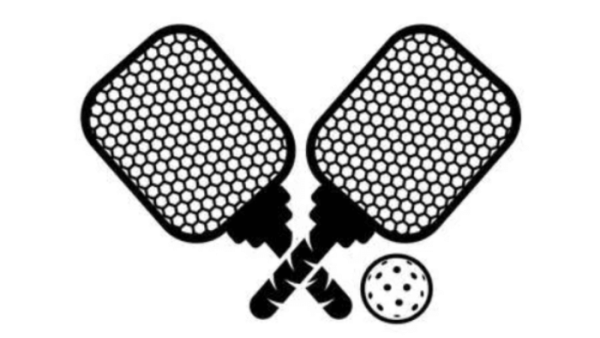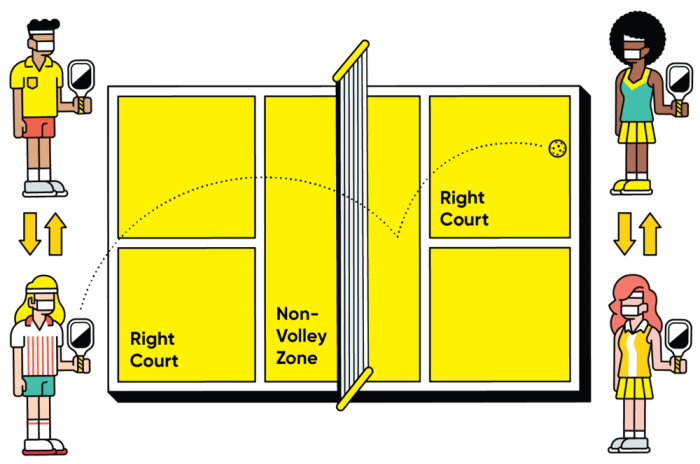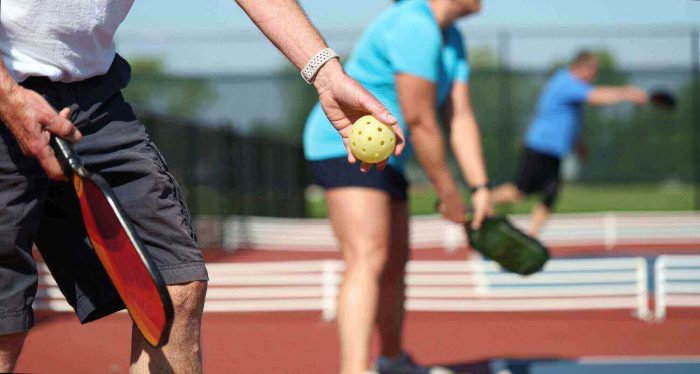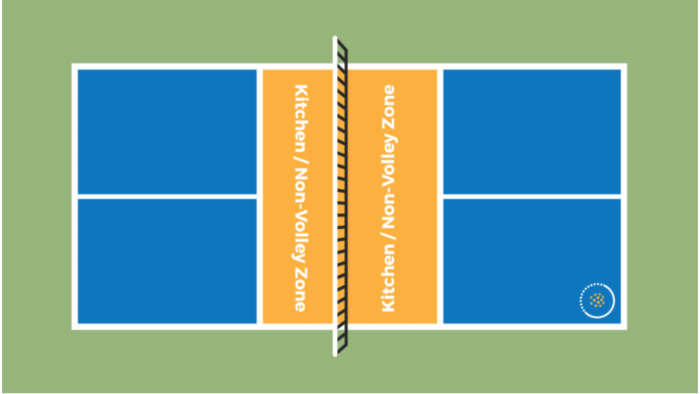Playing Pickleball is an enjoyable sport because of the simplicity of the rules and the ease of understanding them. Getting and staying active is easy with pickleball. Its rules are simple and players can learn the basic pickleball rules and the game in a short time!
Many people play pickleball for fun, or to get some physical activity. The majority of people, however, are genuinely interested in playing this game and want to gain more skills, knowledge, and skills that will enable them to improve and become experts.

After some research and a better understanding, we have gathered some information related to basic pickleball rules, let’s get started!
What You Need To Know About Basic Pickleball Rules?
Basic Pickleball Rules Summary
- The ball must be served underhanded and diagonally to the opponent’s service court without bouncing.
- Only points are scored by the serving side when the opposition faults (for example, failing to return the ball or hitting the ball out of bounds).
- The server continues to alternate serving courts, from one to another, until the serving side of the match faults.
- If the first team scores 11 points and leads by at least a 2-point margin, then they win the game.
- If you want to win by 2 points, you will need to win by 2 points.
- Both sides must make a ground stroke at least once after a service is delivered before hitting the ball into the net when volleying (before the ball bounces).
- A player who is standing within a non-volley zone (also known as the kitchen) cannot volley the ball if they are standing within that zone at that time.
Overall, these Basic Pickleball Rules provide a foundation for understanding the game and are essential for players to follow in order to play a fair and enjoyable match.
The Serve
- When he hits the ball, the server’s arm must make an upward arc.
- Club contact with the ball must not be above hip height.
- The racket head must not be higher than the top of the wrist at the time of contact.
- A drop service is also allowed, in which case none of the above applies.
- At the moment the ball is kicked, the server’s feet must not touch the field of play or outside the imaginary extension of the touchline or halfway line, and at least one foot must be behind the back line of the court or the ground behind the baseline.
- The service is on a cross diagonal and must fall within the confines of the opposite diagonal.
- Only one service attempt is allowed per server.
Serve Sequence Rules

- Only one person can serve the team that starts the game.
- The server always starts on the proper court and must serve in the cross-court (toward the backcourt, diagonally opposite and beyond the non-volley zone line).
- The first teammate to serve in the game calls the score “zero, zero, two”, which means I have 0 points, you have 0 points, and I’m the only server in this streak, so I’m the second server.
- Once the server has scored a point, he always moves to the other court (switches with his partner) for the next service. Never use the same person or service box twice a row. Suppose they get 2 points and somehow fail.
- If the team that serves first commits a foul, the service is transferred or “knocked out” to the opposing team.
- The opposing team starts its first service sequence with the player positioned on the right side of the court. They call the score “zero, two, one” (my score is 0, your score is 2, and the first serve). This team receives a sequence of two service faults (i.e. each person serves until their team commits/fails to score). Suppose this team scores 2 points on the first serve and then misses.
- Second, serves must be served by the team member who played on the opposite side (in this case, left). They call the score “Two, two, two” (my score 2, your score 2, and the second server). The service continues to alternate from side to side as the server continues to score. Suppose they get three more points.
- The loot is now transferred (sideways) to the original starting team, and after that, both players in each loot streak will complete their loot turns. The recovered partition is Two, Five, and one in this example.
- Team points are always even numbers when that team’s initial server is on the right side of the field. Points are always odd when the initial server is on the left side of the field.
Double-Bounce Rule
- As soon as the ball is served, the receiving team bounces it before returning it, so the serving team must bounce it before returning it, resulting in two rebounds.
- After the ball bounces once on each team’s court, either team can volley (hit the ball before it bounces) or play it with a rebound (ground hit).
- As a result of the double jump rule, serves and volleys are no longer advantageous, and rallies are lengthened.
Non-Volley Zone
- There are 7 feet between each net side in the non-volley zone.
- Volleying is prohibited in the non-volley zone. This rule prevents players from taking spikes from within the zone.
- It is a foul if, when shooting a volleyball, the player enters the non-volleyball zone, including the line, and/or if the player’s momentum causes him or anything else he uses, in the non-volleyball zone, to include the line, tap line.
- It is a foul if a player is pushed or touches the non-volley zone after the volley, even if the volley was previously declared dead.
- Players are allowed to be in the non-volley zone at any time, except during ball thefts.
- The no-volley zone is commonly referred to as “the kitchen”.
Scoring
- Serving teams are the only ones who score points.
- Matches are usually played to 11 points and win with 2.
- Tournament games can be 15 or 21, win by 2.
- A player on the serving team (1, 3, 5, 7, 9) is on the left/odd court when serving or returning when the team scores equal (0, 2, 4, 6, 8, 10).
Line Calls & Determining Serving Team
- Balls that hit a line other than the non-volley zone line on a service are considered inbounds.
- It is used to contact the non-volley zone line when it is shorted and causes a fault.
- A coin toss determines the first service. If the winner of the draw is the winner of the draw, he or she can choose a side to participate in.
Faults
- A foul is any action that stops play for breaking a rule.
- A foul by the receiving team results in a point for the serving team.
- A failure of the serving team will result in the service’s loss or the server’s elimination.
- An error occurs when:
- There is a problem when the receiving court’s boundaries are outside the service boundaries.
- On a serve or return, the ball is hit into the net.
- The ball is hit before the rebound takes place on either side.
- The ball is hit far.
- A ball is ejected from the non-volley zone.
- A ball bounces twice before being hit by the catcher.
- A player, a player’s clothing or any part of a player’s club comes into contact with the net or net post when the ball is in play.
- There is a violation of a Service Policy.
- A ball in play hits a player or something the player is wearing or carrying.
- A ball in play hits a solid object before bouncing on the field of play.

General Rules Applicable To All
Other Basic Pickleball Rules
- Hitting the ball by hand: Balls hit with the racket hand below the wrist while holding the racket are legal. It is a foul if the ball hits another part of the body. Hitting the ball by hand: Balls hit with the racket hand below the wrist while holding the racket are legal. It is a foul if the ball hits another part of the body.
- Hitting the ball by hand: Balls hit with the racket hand below the wrist while holding the racket are legal. It is a foul if the ball hits another part of the body. Hitting the ball by hand: Balls hit with the racket hand below the wrist while holding the racket are legal. It is a foul if the ball hits another part of the body.
- Hitting the ball by hand: Balls hit with the racket hand below the wrist while holding the racket are legal. It is a foul if the ball hits another part of the body.
- A ball “out” is not “out” until it bounces. Never grab it, and never let it kick you in the air.
- Double/Carry Hits: During a continuous stroke, it is legal to hit a ball in one direction even if the ball is hit twice unintentionally or if it is “carried”.
- Switching Hands: The paddle may be switched from hand to hand at any time. Two-handed shots are also legal.
- Reaching over the net: When a ball bounces onto your side and spins back over the net, you can reach over the net to hit the ball. The return is valid if your paddle or you do not touch the net.
- Fault vs Partner Communication: In the event that a partner hits the ball, a player can call it out immediately. You can yell “bounce it”, “let it go”, “no”, or “out” if you wish to tell your partner not to hit it. “Out” is considered communication between players. After the ball touches the court, it is called an “out” call.
- Around the net: Balls travelling around the post and not passing through the net are not considered to have crossed into the opponent’s court.
- Singles Play: Singles play follows all doubles rules except:
- Generally, singles serve from the Right side of the court when the score is 0 or even and from the Left side if the score is “1,3,5, etc.”.
- Conduct of Play: Pickleball is a friendly and social game where we demand a code of ethics and proper manners at all times. Those who violate our conduct of play can receive everything from a warning to suspension from the CTPA or tournament. Good sportsmanship and the honor system guideline are calling.
Calling balls out:
- You should defer to the player who is closest and has the best visual angle.
- It is important to rule in your opponents’ favor on questionable calls.
- Contact me as soon as possible.
- It is important that you accept your opponent’s opinion whenever you request it.
Try to make the fairest call you can, and always respect the call made by the player closer to the ball than you. Bad calls happen, so maintain a positive attitude and demeanor.
Please try to be courteous to others and follow basic pickleball rules. There should be no fighting, shouting, threatening, or swearing. Anyone who feels threatened or abused by another player should contact CTPA, Cranberry Parks & Recreation, or 911.
What Are the Basic Pickleball Rules for Wrong Scores?

As with any sport, pickleball is always subject to human error, and both referees and players can occasionally make mistakes when calling out the score of a pickleball game. In response to this possibility, Rule 4 of your question What Are The Pickleball Rules contains a subsection detailing the procedure for responding to an incorrect score. The rule states that two things must happen if the server or the referee calls an incorrect score.
Firstly, if the service is made and returned, play must continue until the rally is finished, with one team either scoring a point or committing a foul. The score may be corrected after the rally ends by any player. This must be done before the next serve. The basic pickleball rules also allow players to call for a score correction immediately before the initial serve is returned, in which case the score will be corrected and the serve replayed without penalty.
In pickleball, if a player calls for a score correction prior to returning the service, but the score was determined to actually be correct, the player will receive a fault, and their side will lose the rally. A player will also be faulted if they call for play to stop after the initial service has been returned on account of an incorrect score.
FAQs
Volleying is prohibited within the non-volley zone, an area on pickleball courts within 7 feet of both nets marked with a line.
Parking volleyball in the non-volley zone is prohibited, which prevents smashes from the net.
Stepping into the non-volley zone or even on the line when volleying is an offence.
It is a fault when your momentum takes you into the kitchen after a volley or causes you to touch the line after a volley.
In the non-volley zone, you may stand at any time, so long as you aren’t turning the ball.
It is important to remember that the 10-second rule in pickleball is an important yet simple rule concerning all services, and specifically, that once the score has been called, the server has 10 seconds to take a serve. A server will be called for a fault if they fail to launch the service within this 10-second window.
As the server on the pickleball court, it is essential to be aware of certain limitations (see the Official USA Pickleball Rule book for the 2020 version) that you must adhere to. The server has no more than 10 seconds to serve a pickleball upon calling the score (whether the referee or the server called it).
End Note
I hope this article helped you understand the Basic Pickleball Rules and provided some great facts! Getting started with pickleball is as easy as reviewing some of the basic rules we described, and you will be ready to go. Let the grandkids or friends play pickleball, and grab some paddles and gear for an awesome time.
Wishing you a great match!



